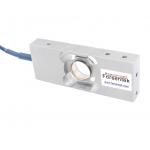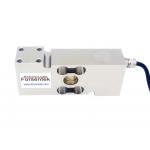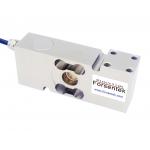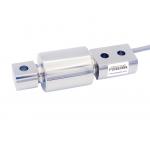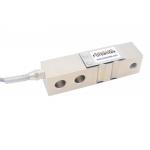Miniature Load Cell 30g Micro Weight Sensor 30g Weighing Transducer
Low Capacity Miniature Load Cell FMJ-30g is made of aluminum
based on strain gauge technology with 30g rated capacity, high
accuracy with 0.05% non-linearity of the full scale. You may find
low range load cell FMJ-30g suitable for electronic balance,
jewelry scales and other industrial weighing applications.
Dimensions
Specifications
| Capacity | 30g |
| Rated output | 0.5±0.15mV/V |
| Excitation | 3-10V |
| Zero balance | ±0.1mV/V |
| Nonlinearity | ±0.05% R.O. |
| Hysteresis | ±0.05% R.O. |
| Nonrepeatability | ±0.05% R.O. |
| Creep(2min) | ±0.05% R.O. |
| Safe overload | 150% F.S. |
| Ultimate overload | 200% F.S. |
| Compensated temperature | -10...+40oC |
| Operating temperature | -20...+60oC |
| Temperature shift zero | ±0.1% R.O./oC |
| Temperature shift span | ±0.05% R.O./10oC |
| Input resistance | 1150±100 ohms |
| Output resistance | 1050±100 ohms |
| Insulation resistance | >2000M ohms |
| Ingress protection | IP50 |
| Material of element | Aluminum alloy |
| Cable | AWG32*90(Longer cable available) |
| Wiring code | Red--Excitation+ Black--Excitation- Green--Signal+ White--Signal- |
A load cell is used to determine mass: The weight force exerted by
the sample is converted into an electrical signal by the load cell.
Load cells are therefore the most important components of an
electronic scale. One of the most widely used technologies is based
on strain gauge technology: an analog load cell consists of a
measuring element (so-called spring body) made of steel or
aluminum, on which strain gauges (Wheatstone bridge) are mounted,
strain gauges are electrical resistors that change their resistance
while loaded, these resistance change leads to the change of output
signal, the load/weight then can be measured and evaluated by
measuring the output signal from the wheatstone bridge. Overloading is the most common cause of loadcell failure, a load
sensor is just like a spring in certain aspects, which will be
damaged if overstretched or overloaded. A machanical stop can be
used to protect the sensor from excessive deformation. The
deformation gap can be determined by loading the sensor with rated
capacity, then adjust the meachnical stop to reach the bottom of
the transducer. In most cases, the load cell will be used to
measure load at 40-80% of the full capacity, thus the deformation
gap can be adjusted using reference load a bit higher than the
target load to be measured instead of the rated capacity.
Miniature Load Cell 30g Micro Weight Sensor 30g Weighing Transducer
Click here to download datasheet
